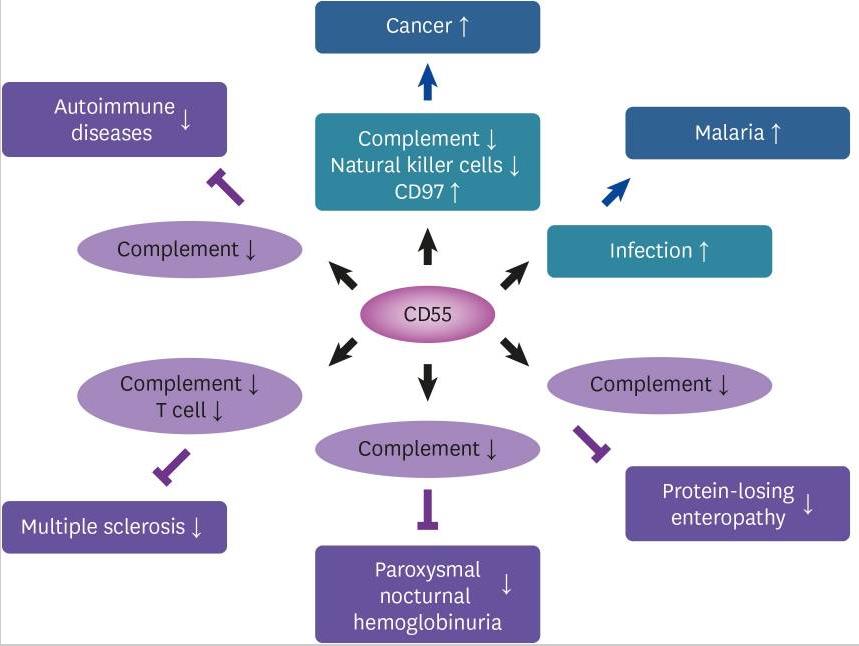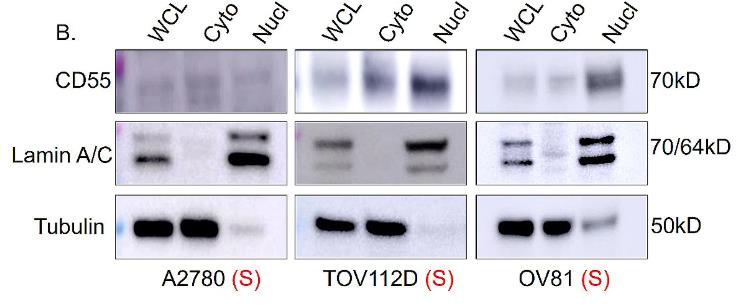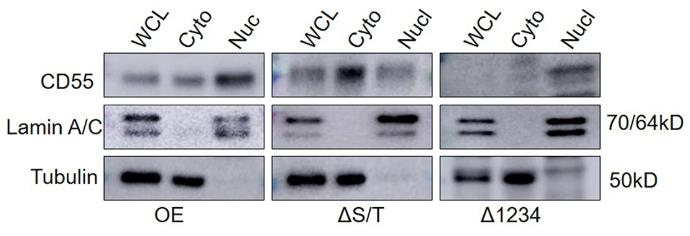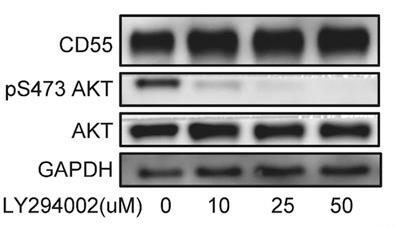CD55
-
Official Full Name
CD55 molecule, decay accelerating factor for complement (Cromer blood group) -
Overview
CD55 is a 60-70 kD glycosylphosphatidylinositol (GPI)-anchored single chain glycoprotein also known as decay-accelerating factor (DAF). It is expressed on hematopoietic cells including erythrocytes and many non-hematopoietic cells. CD55 accelerates the di -
Synonyms
CD55;CD55 molecule, decay accelerating factor for complement (Cromer blood group);DAF, decay accelerating factor for complement (CD55, Cromer blood group system);complement decay-accelerating factor;CR;CROM;TC;CD55 antigen;DAF
Recombinant Proteins
- Human
- Mouse
- Rat
- HEK293
- Insect Cells
- E.coli
- Wheat Germ
- Human Cells
- In Vitro Cell Free System
- Mammalian Cells
- Fc
- His
- GST
- Non
Background
What is CD55 Protein?
CD55, also known as decay-accelerating factor, is a protein that plays a big role in controlling the complement system, which is a part of our immune defenses. It acts on the cell surfaces to regulate the complement pathways, ensuring they don't go overboard and damage our own cells. Found in various types of cells in the body, it's crucial in preventing excessive immune reactions and thus helps in shielding healthy cells from unintended harm. Apart from that, CD55 is involved in the formation of the Cromer blood group system, which is one way blood types are classified. Its functions highlight the intricacies of our immune system and its balance between responding to threats and protecting our own cells.
What is the Function of CD55 Protein?
CD55, also known as Decay-Accelerating Factor (DAF), acts like a diligent cell guardian, ensuring that our immune system's complement pathway doesn't spiral out of control and damage our own cells in its efforts to fend off invaders. By recognizing specific fragments like C3b and C4b, which pop up when the immune system is activated, CD55 cleverly disrupts steps in the complement cascade, thus halting the assembly of the membrane attack complex that can damage cells. In simpler terms, it acts like a traffic control officer, directing the immune response so it attacks invaders and not our own cells. You'll find CD55 distributed widely across different cell types, balancing this delicate immune dance. It also interacts with viruses like enteroviruses, sometimes serving as a doorway they could exploit to infect cells. Plus, its deficiency can link to certain diseases like paroxysmal nocturnal hemoglobinuria, a condition where red blood cells are unjustly attacked by the immune system. Overall, CD55 is essential in maintaining immune balance, making sure our body's defenses are tough yet gentle, fighting off invaders without self-sabotage.
CD55 Related Signaling Pathway
CD55, or Decay-Accelerating Factor, wields significant clout in immune system signaling, specifically when dealing with the complement system, which is like the body's immune battalion. This protein mingles with certain fragments, named C4b and C3b, that pop up during different activation paths of the complement system. Think of CD55 as a quick-thinking moderator that jumps in to either stop or slow down the formation of specific enzyme complexes such as C3-convertase by disrupting their development. By doing this, it prevents an excessive immune response, thereby stopping the complement system from turning on the body's own cells, which could cause damage. In a nutshell, CD55 plays a regulatory role, ensuring the complement system doesn't go off the rails and cause unwanted collateral damage in our body's ongoing battle against invaders.
CD55 Related Diseases
CD55, or the Decay-Accelerating Factor, plays a part in several health conditions mainly due to its role in the immune system. One notable condition is Paroxysmal Nocturnal Hemoglobinuria (PNH), where due to problems with CD55 being tethered properly to cell membranes, red blood cells get mistakenly attacked by the immune system, leading to symptoms like fatigue and dark urine. Beyond PNH, CD55 is implicated in certain infectious diseases as well. Some viruses exploit CD55 as a doorway to enter and infect cells, which is a bit like them sneaking in by holding a fake credential. For instance, enteroviruses, including certain types of coxsackieviruses, latch onto CD55 to cause infections. This manipulation by viruses underscores CD55's complex role, sometimes acting as an unintentional accomplice in viral pathogenesis, an area of ongoing research to effectively target and possibly correct these interactions.

Fig1. The role of CD55 in various diseases. (So Hee Dho, 2018)
Bioapplications of CD55
Recombinant CD55 protein really finds its groove across various research-driven sectors like scientific studies, clinical applications, and even industrial production. In the lab, it's a handy tool for diving into the nitty-gritty of the immune system and figuring out how to keep complement pathways in check. Clinically, it shows potential in developing therapies aimed at minimizing unwanted immune attacks, which could be a game-changer for certain autoimmune conditions or in transplant scenarios. Industry-wise, recombinant CD55 could play a part in manufacturing processes, especially those looking at creating immune-modulating products or testing immune responses more effectively. So, this protein is a bit of a jack-of-all-trades, flexing its muscle in several different yet interconnected fields.
Case Study
Case Study 1: Rashmi Bharti, 2024
Platinum resistance significantly affects survival rates in ovarian cancer patients. Key to tackling this is targeting therapies and understanding chemoresistance biomarkers. Research highlights that CD55, a complement regulatory protein on cell surfaces, fuels chemoresistance and sustains cancer stem cells (CSCs), which are linked to tumor comeback and metastasis. Techniques like immunofluorescence pinpoint CD55's location on the cell surface and nucleus, showing it aids cisplatin resistance. Particularly, nuclear CD55 comes from its surface counterpart and relies on a trafficking code involving a serine/threonine domain. This domain is crucial for nuclear entry and cisplatin resistance, as removing it makes resistant cells more susceptible to treatment. In the nucleus, CD55 interacts with, and dampens, the tumor suppressor ZMYND8 while increasing H3K27 trimethylation, enhancing resistance profiles.

Fig1. Nuclear fractions isolated followed by SDS-PAGE and immunoblotting for CD55 protein.

Fig2. CD55 immunoblot of CD55 OE, ΔST, and Δ1234 transduced CP70 KO cells.
Case Study 2: Zhijing Tang, 2022
Decidualization is super important for an embryo to implant and for pregnancy to stick around, and when things go wrong with this process, it can lead to miscarriages. This study focused on how CD55 plays a part in this whole human decidualization thing. It turned out that CD55 levels are higher in early pregnancy tissue compared to the regular endometrium. When cells were made to mimic decidualization in the lab, using MPA and 8-Br-cAMP, CD55 was increased. However, knocking down CD55 reduced important decidualization markers like PRL and IGFBP1 and affected other gene expressions. Women with unexplained miscarriages or infertility showed lower CD55 levels, pointing to its potential role in these conditions.

Fig3. Western blot analysis of CD55, PRL, and IGFBP1 in T-hESCs treated with MPA 8-Br-cAMP.

Fig4. Western blot analysis of CD55 expression and AKT phosphorylation in T-hESCs pretreated with gradient doses of LY294002.
Quality Guarantee
High Purity
.jpg)
Fig1. SDS-PAGE (CD55-2325H)
.
.jpg)
Fig2. SDS-PAGE (CD55-694H)
Involved Pathway
CD55 involved in several pathways and played different roles in them. We selected most pathways CD55 participated on our site, such as , which may be useful for your reference. Also, other proteins which involved in the same pathway with CD55 were listed below. Creative BioMart supplied nearly all the proteins listed, you can search them on our site.
| Pathway Name | Pathway Related Protein |
|---|
Protein Function
CD55 has several biochemical functions, for example, carbohydrate binding. Some of the functions are cooperated with other proteins, some of the functions could acted by CD55 itself. We selected most functions CD55 had, and list some proteins which have the same functions with CD55. You can find most of the proteins on our site.
| Function | Related Protein |
|---|---|
| carbohydrate binding | SIGLEC7,MAN2A2,DGCR2,CNTN2,ATRNL1,FBXO6,ASGR1,GFPT2,CLEC4E,OLR1 |
Interacting Protein
CD55 has direct interactions with proteins and molecules. Those interactions were detected by several methods such as yeast two hybrid, co-IP, pull-down and so on. We selected proteins and molecules interacted with CD55 here. Most of them are supplied by our site. Hope this information will be useful for your research of CD55.
ganglioside_gm1;LCK;glyA;q5nfy5_fratt;q5ngt6_fratt;ywqA;q914e0_9ento
Resources
Related Services
Related Products
References
- Herrero, R; Real, LM; et al. Association of complement receptor 2 polymorphisms with innate resistance to HIV-1 infection. GENES AND IMMUNITY 16:134-141(2015).
- Le Bas-Bernardet, S; Tillou, X; et al. Bortezomib, C1-Inhibitor and Plasma Exchange Do Not Prolong the Survival of Multi-Transgenic GalT-KO Pig Kidney Xenografts in Baboons. AMERICAN JOURNAL OF TRANSPLANTATION 15:358-370(2015).


